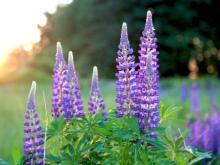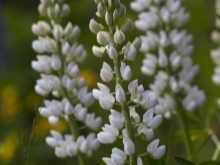Lupine multifoliate: the best varieties and growing rules

There are a great many varieties and types of lupine. I must say that some of them require special care. Consider the multifoliate lupine, which gardeners value so much, and the rules for its cultivation.



Description
It should be noted that this flower can be annual and perennial. It can be considered both a shrub and a semi-shrub. It belongs to the legume family, and the name itself is translated as "wolf".
Lupine has a taproot. Its length is considerable and can be about 2 meters deep. This plant has a wide palette of shades. Small flowers gather in inflorescences, the shape of which resembles a candle. The buds can be arranged in two ways: alternately or whorly. Experts estimate that there are more than 200 varieties of this plant.



The stem is erect and strong enough. Its height ranges from 80 to 120 centimeters. The leaves are pubescent at the bottom. Inflorescence clusters reach a length of 30-35 centimeters. Perennial lupine boasts a fruit that is a seed-bearing pod. Each of the beans can hold about 45 seeds, which germinate within 3-4 years. The flowering period of the plant occurs in early summer and usually lasts about a month.
Gardeners often grow lupines for an ornamental function. However, both the stem and the seed can be used in the food industry. The stems have proven to be excellent for decorative crafts. Seeds are successfully used in medicine, they are a component in the manufacture of, for example, plasters, soaps, cosmetics and other drugs.


Review of popular varieties
It is assumed that the place of origin of the multi-leaved lupine is North America. Accordingly, its varieties can feel quite comfortable even in the cold regions of our country. Some of them can be found even in wild taiga forests.
Perennial lupine comes in a huge variety of varieties. They have a number of differences, such as flower color, flowering period and size. Gardeners appreciate them for the huge number of shades in the color.


Popular varieties include the following:
- "Schloss Frau" has inflorescences of a pleasant pink hue;
- "May castle" has bright red flowers, looks very advantageous in various compositions, attracts attention;
- "Castellane" - a variety that has blue inflorescences with a purple tint;
- "Abendglut" is a plant with dark red flowers;
- "Albus" - lupine with snow-white inflorescences;
- "Ze Chaitelein" - a variety that is distinguished by pale pink flowers with a white sail, looks especially bright and advantageous in partial shade;
- grade "Apricot" pleases gardeners with catchy orange inflorescences;
- "Neue Spillarten" they are distinguished by interesting inflorescences of pinkish-orange colors;
- "Princess Juliana" has pink and white flowers, looks very delicate;
- Rubinkönig - a variety with ruby-purple inflorescences.



Where to plant?
The plant is quite unpretentious, but in advance you should choose a place for planting it. This must be done taking into account the variety, since the preferences of lupines may be different. However, there are some general guidelines that all gardeners should adhere to.
Location and lighting play a role. Most often, lupins are planted in the spring, from April to the first ten days of May, or in autumn. You need to choose a sunny area or partial shade, the shrub will feel equally good in each case. However, a strong shade should be avoided, otherwise the plant will simply not take root. If the procedure is planned to be carried out in the spring, the place is prepared even before the first frost begins.


The type of soil does not play a big role. Lupins require loose and fresh soil, which must be enriched with nutrients in advance with the help of dressings. This will have the best effect on their flowering.
Plants feel best on slightly alkaline or slightly acidic soil. Ideally, it should be sandy or loamy. Lime or dolomite flour must be added to the soil with a high acidity level. If this is not done, the lupins will be very weak, and the leaves will turn pale. A similar procedure is performed once every 5 years. Peat is added to alkaline soils, its presence protects the shrub from leaf chlorosis.


Reproduction
This culture can be propagated in two ways - by seeds and cuttings. Let's consider each in more detail.
Seed
After the beans are ripe, they crack, and the wind blows the seeds around. To obtain seedlings, the soil is first prepared and fertilized. The seeds are able to remain viable for 5 years. They should not be buried too deep, but you can moisten them by simply covering them with a damp cloth. The first shoots appear after 2 weeks. Transplantation to a permanent place is necessary no later than 4-5 leaves will appear on the seedling.
The seeds can also be germinated outdoors. The distance between them should be between 30 and 50 centimeters.
Experts recommend sowing them in late October and early November, then seedlings will appear in spring, and lupins will bloom in August.

Vegetative
Only plants that have reached 3 years of age can be propagated by cuttings. Lupins, which are 5-6 years old, do not have lateral buds, so grafting in this case is more difficult to carry out. To do this, you will need to cut off the buds in the base area with a sharp knife, grabbing the root collar, and plant them in the shade, on sandy soil. After a month, the cutting with a developed root system can be transplanted to a permanent place.
The procedure is recommended in spring. Be sure to do top dressing. To do this, mix peat, turf and sand in a ratio of 2: 2: 1.

Care rules
This culture does not require special care. It must be weeded on time and provided with top dressing, then the plant will feel good and grow actively. In addition, the soil will need to be periodically loosened and watered.
If the lupins are located in an area open to gusts of wind, you should consider supporting. Its role can be played by ordinary wooden pegs. In addition, an adult shrub must be pruned in time, removing dry inflorescences. Warming will be required for the winter in regions characterized by a strong drop in temperature. For this, peat and sawdust are usually used.


Preventive measures will help protect lupins from possible diseases. Plants are susceptible to spotting, gray and root rot, rust and mosaic. They can be seriously damaged by aphids, root weevils and other pests. Gardeners need to keep in mind that a sudden change in plant color indicates serious problems and must be removed. Upon reaching the age of 5, the adult shrub is replaced by young seedlings.
2-year-old lupins need to be fed with mineral supplements. Fertilizers are applied in early spring, before flowering begins. Superphosphate and potassium chloride are great. It is also useful to introduce nitrogen fertilization and organic matter. Adding wood ash is a good option. Magnesium must be added to sandy soil.


For information on how to grow lupines, see the next video.



































































































The comment was sent successfully.